Pooja Mohan Moger, Riya Montheiro, Roviana Valissa Sequeira, Seema D. Manvar, Jovita Vani Sequeira
Department of Computer Science and Engineering, St. Joseph Engineering College, Mangalore, India
Correspondence to: Jovita Vani Sequeira, Department of Computer Science and Engineering, St. Joseph Engineering College, Mangalore, India.
| Email: |  |
Copyright © 2017 Scientific & Academic Publishing. All Rights Reserved.
This work is licensed under the Creative Commons Attribution International License (CC BY).
http://creativecommons.org/licenses/by/4.0/

Abstract
Agriculture plays a crucial role in the economy of developing countries and provides main source of food, income and employment to their rural population. Agriculture is the backbone of the economy of a country. Although we all currently rely on the industrial agriculture to produce the majority of food we consume, this type of agriculture is facing problems. The main disadvantage of agriculture is long hours, poor pay and hard labor. To avoid this we come up with modern technologies and make the work of farmers easier. The internet of things is modifying agricultural industry and enabling farmers to cope with the enormous challenges they face. These technologies include weeding, switching On/Off the water pump, animal and bird scaring, temperature, humidity and moisture detection using appropriate sensors.
Keywords:
Automation, Bluetooth
Cite this paper: Pooja Mohan Moger, Riya Montheiro, Roviana Valissa Sequeira, Seema D. Manvar, Jovita Vani Sequeira, Smart Agriculture, International Journal of Internet of Things, Vol. 6 No. 2, 2017, pp. 83-87. doi: 10.5923/j.ijit.20170602.16.
1. Introduction
About 70% of population of India lives in villages. The core occupation of people who live in villages is agriculture (farming). Yet India is not self-sufficient in producing enough food. Every year hundreds of tons of food-grains are imported from foreign countries. Agriculture is of extreme importance for the progress of developing country like India. Internet of things has been proving its tenacity across industries. Among the different industries the one sector it is quickly catching up with is, the agriculture. With the idea of smart farming and digitalization, it is gaining popularity like never before, and is coming with the ability to provide high precision crop control, data collection and automated farming techniques. Agriculture is considered as the basis of life for the human species, as it is the main source of food grains and other raw materials. But agriculture in India is mostly depended upon natural resources and weather condition plays an important role. This paper suggests internet of things based sensor network for agricultural use, smart water irrigation, bird and animal scarring methods and robotic grass cutter. The sensors such as temperature and humidity help the farmer monitor the weather conditions and also keep track of the previous conditions [1]. Knowing the exact soil moisture conditions on their fields, not only are farmers able to generally use less water to grow a crop, they are also able to increase yields and the quality of the crop by improved management of soil moisture during critical times of need.In urban and suburban areas, landscapes and residential lawns are using soil moisture sensors to interface with an irrigation controller. Water pumps can be turned ON/OFF as and when needed. Connecting a soil moisture sensor to a simple irrigation clock will convert it into a "smart" irrigation controller that prevents irrigation cycles when the soil is already wet, e.g. following a recent rainfall event. Golf courses are using soil moisture sensors to increase the efficiency of their irrigation systems to prevent over-watering. The IOT based robotic grass cutter can be used to cut grass in the fields, directions can be changed by passing commands. Monitoring environmental factors alone is not enough and is not a complete solution to improve yield of crops. There are a number of other factors that affect the productivity, one such factor is, attack from wild animals and birds when the crops grow. For this purpose PIR animal repellent sensors can be placed in farms along with the voice playback modules, this will detect an intruder if any and scare them away by playing the voices from the module, and will inform the farmer about the intruder. Controlling all these operations will be through any remote smart device or computer connected to the internet or Bluetooth, operations will be performed by interfacing sensors, Bluetooth modules, WI-FI, Zigbee modules, actuators with micro-controller and Ardino UNO R3. In this project we have used the Bluetooth connection, because Wi-Fi connection services can turn out to be expensive, and there may also be network issues. Since our focus is on farmers and their fields, we have Bluetooth module, to make the model cost effective.
2. System Overview
Some operations are meant for field purposes and some can be handled or controlled sitting at home. Here the model is divided into nodes in the figures based on their area of usage.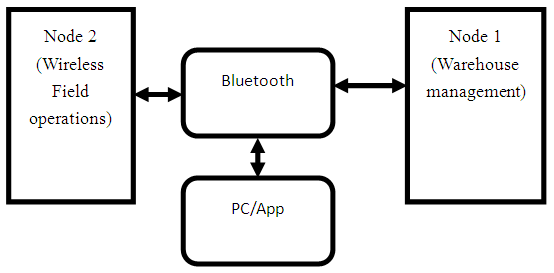 | Figure 1. System Overview Part 1 |
 | Figure 2. System Overview Part 2 |
The paper consists of four sections node1, node 2, node 3 and PC or mobile app to control the system. In the system, every node is in integration with different sensors and devices and they are interconnected to one central server via wireless communication modules. The server sends and receives information from user end using Bluetooth connectivity. We use only the manual mode of operation, where the user can control the operations of system using a windows application or PC commands [2].ARCHITECTURE OF THE SYSTEM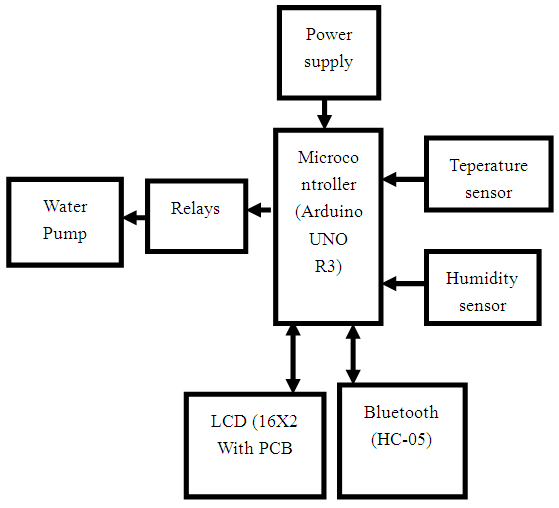 | Figure 3. Node 1 |
Part 1-Node 1: Node1 will be the warehouse management which consists of humidity sensors, temperature sensors and the water pump. Temperature and humidity sensor senses the temperature and humididty respectively. These values stored in the database and a graph is plotted, with the values vs the days, for later reference purpose. Node 2 also has the water pump operation, the pump can be switched ON/OFF manually depending on the soil moisture notification we get from node 2.PART 1-Node 2: In node 2, moisture sensor with voltage comparator is used to detect the soil moisture. The transmitted data is displayed on the LCD, and the user is given notification about it. And then the user can decide if/not to switch on the water pump in node 1, as per the need. There is also the animal and bird scarring PIR sensors, that detect the intruder within a certain bandwidth limit and responds by playing the scarring voices that are recorded in the playback module, when an intruder is detected. It is to be noted that at the max 8 voices can be recorded in the playback module.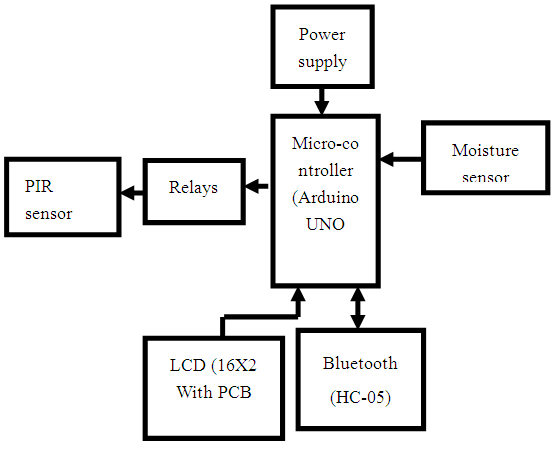 | Figure 4. Node 2 |
Part 2: Node 3: The grass cutter is a robotic moving device, which is connected to our phone or PC through the Bluetooth and then can be operated, by changing the directions as per the users need.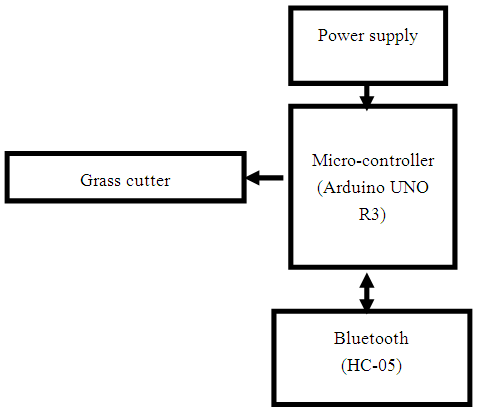 | Figure 5. Node 3 |
3. Architecture of the System
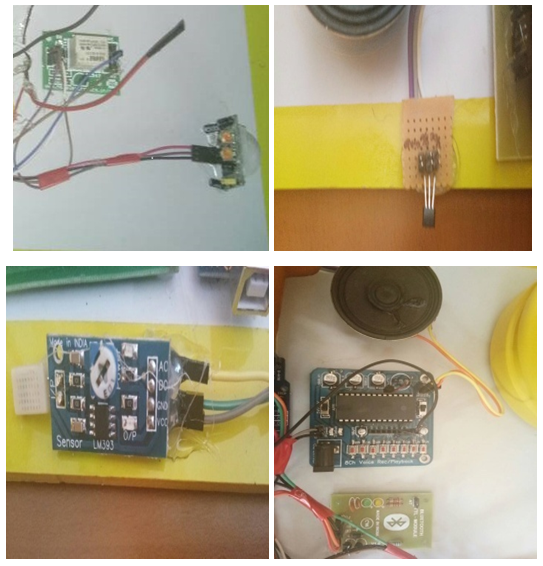 | Figure 6. Hardware Components |
Hardware used:a) Arduino Uno- R3:This is the new Arduino Uno R3. In addition to all the features of the previous board, the Uno now uses an ATmega16U2 instead of the 8U2 found on the Uno (or the FTDI found on previous generations). This allows for faster transfer rates and more memory. No drivers needed for Linux or Mac (inf file for Windows is needed and included in the Arduino IDE), and the ability to have the Uno show up as a keyboard, mouse, joystick, etc. The Uno R3 also adds SDA and SCN pins next to the AREF. In addition there are two new pins placed near the RESET pin. One is the IOREF that allows the shields to adapt to the voltage provided from the board. The other is the not connected and is reserved for future purposes. The Uno R3 works with all existing shields but can adapt to new shields which use these additional pins. Arduino is an open source physical computing platform based on a simple I/O board and development environment that implements the processing/wiring language. Arduino can be used to develop stand alone interactive objects or can be connected to software on your computer (e.g. flash, processing, maxMSP). The open source IDE can be downloaded for free (currently for Mac OS X, Windows, Linux [3].b) LCD (Liquid Crystal Display) 16X2:LCD (Liquid Crystal Display) screen is an electronic display module and find a wide range of applications. A 16*2 LCD display is very basic module and is very commonly used in various devices and circuits. These modules are preferred over seven segments and other multi segment LEDs. The reasons being: LCDs are economical; easily programmable; have no limitation of displaying special & even custom characters (unlike in seven segments), animations and so on. A 16*2 LCD means it can display 16 characters per line and there are 2 such lines. In this LCD each character is displayed in 5*7 pixel matrix. This LCD has two registers, namely, Command and Data. The command register stores the command instructions given to the LCD. A command is an instruction given to LCD to do a predefined task like initializing it, clearing its screen, setting the cursor position, controlling display etc. The data register stores the data to be displayed on the LCD. The data is the ASCII value of the character to be displayed on the LCD. c) Relays: A relay is an electrically operated switch. Many relays use an electromagnet to mechanically operate a switch, but other operating principles are also used, such as solid state relays. Relays are used where it is necessary to control a circuit by a separate low power signal, or where several circuits must be controlled by one signal. The type of relay that can handle the high power required to directly control an electric motor or other loads is called contactor. Because relays are much more resistant than semiconductors to nuclear radiation, they are widely used in safety critical logic, such as the control panels of the radioactive waste handling machinery. Electromechanical protective relays are used to detect overload and other faults on electrical lines by opening and closing circuit breakers.d) Soil Moisture Sensors:Soil moisture sensors measure the volumetric water content in the soil. Since the direct gravimetric measurement of free soil moisture requires removing, drying and weighing of a sample, soil moisture sensors measure the volumetric water content indirectly by using some other property of the soil, such as electrical resistance, dielectric constant, or interaction with neutrons, as a proxy for the moisture content. The relation between the measured property and soil moisture must be calibrated and may vary depending on environmental factors such a soil type, temperature, or electric conductivity.e) Temperature Sensor:The LM35 series are precision integrated circuit temperature devices with an output voltage linearly proportional to the centigrade temperature. The LM35 device has an advantage over linear temperature sensors calibrated in Kelvin as the user is not required to subtract a large constant voltage from the output to obtain convenient scaling. The device is used with single power supplies, or with plus and minus supplies. The low output impedance, linear output and precise inherent calibration of the LM35 device makes interfacing to read out or control circuitry especially easy.f) Humidity Sensor:A humidity sensor senses, measures and reports the relative humidity in the air. It therefore measures both moisture and air temperature. Relative humidity is the ratio of actual moisture in the air to the highest amount of moisture that can be held at the air temperature. Humidity can be used as monitoring and preventive measures in homes for people with illness that are affected by humidity. They are also found as part of home heating, ventilating, and air conditioning systems. They can also be found in offices, cars, museums, industrial spaces and greenhouses and can be used in meteorology stations to report and predict weather. [4] g) PIR Sensors:The PIR sensor has two slots in it, each slot is made of a special material that is sensitive to IR. The lens used here is not really dong much so we see that the two slots can ‘see’ out past some distance. When the sensor is idle, both slots detect the same amount of IR, the ambient amount radiated from the room or walls or outdoors. When a warm body like human or animal passes by, it first intercepts one half of the PIR sensor, which causes a positive differential change between the two halves. When the warm body leaves the sensing area, the reverse happens, whereby the sensor generates a negative differential change, these change pulses are what is detected. [5]Software requirements:a) Visual Studio 2010:Microsoft Visual Studio is an Integrated Development Environment (IDE) from Microsoft. It is used to develop computer programs for Microsoft Windows, as well as web sites, web applications and web services. Visual Studio uses Microsoft software development platforms such as Windows API, Windows Forms, Window Forms, Windows Presentation Foundation, Windows store and Microsoft Silver light. It can produce both native code and managed code.Visual Studio includes a code editor supporting intelligence (the code completion component) as well as code refactoring. The integrated debugger works both as a source level debugger and a machine-level debugger. Other built-in tools include a forms designer for building GUI applications, web designer, class designer and database schema designer.Visual Studio supports different programming languages and allows the code editor and debugger to support programming language, provided a language-specific service exists. Built-in languages include C, C++ and C++/CLI (via visual C++), VBNET (via Visual Basic.NET), C# (via Visual C#), and F# (as of visual studion 2010).b) MySQL: MySQL is the world’s most widely used open source Relational Database Management System (RDBMS) that runs as a server providing multi-user access to a number of databases. The MySQL development project has made it source code available under the terms of the GNU General Public License, as well as under a variety of proprietary agreements. MySQL was owned and sponsored by a single for-profit firm, the Swedish company MySQL AB, now owned by Oracle Corporation. MySQL is a popular choice of database for use in web application software stack. LAMP is an acronym for “Linux, Apache, MySQL, and Perl/PHP/Python” Free software – open source projects that require a full feature database management system often use MySQL.c) ASP.NET:ASP.NET is a set of web development tools offered by Microsoft. Programs like Visual Studio.NET and Visual Web Developer allow Web developers to create dynamic websites using a visual interface. Of course, programmers can write their own code and scripts and incorporate it into ASP.NET websites as well. Though it is often seen as a successor to Microsoft’s ASP programming technology, ASP.NET also supports Visual Basic. NET, Jscript.NET and open source languages like Python and Perl.ASP.NET is built on the .NET framework, which provides an application program interface (API) for software programmer. The .NET development tools can be used to create application for both the Windows operating system and the Web. Programs like Visual Studio. NET provide a visual interface for developers to create their applications, which makes. NET a reasonable choice for designing Web-based interfaces as well. In order for an ASP.NET website to function correctly, it must be published to a web server that supports ASP.NET applications. Microsoft’s Internet Information Services (IIS) Web server is by far the most common platform for ASP.NET websites. While there are some open source options available for Linux based systems, these alternatives often provide less than full support for ASP.NET applications. [5]
4. Experiment and Results
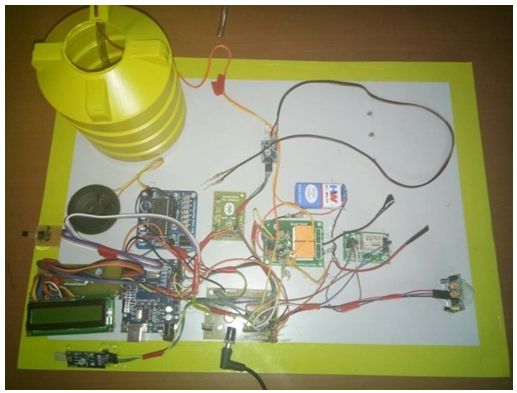 | Figure 7. Experimental setup for Node 1 |
As shown in the figure, experimental setup for Node1, consists of smart agriculture with arduino IDE, relays, power supply, battery, voice playback module, display, Bluetooth module and other sensors are interfaced with microcontroller. Test results shows that the model can be controlled using the wireless transmission of PC commands.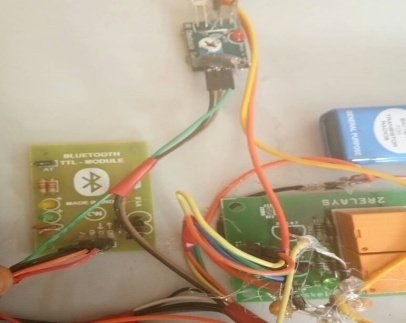 | Figure 8. HC-05 Bluetooth Connectivity |
The module has two modes of operation, Command Mode where we can send AT commands to it and Data Mode where it transmits and receives data to another bluetooth module.The default mode is DATA Mode, and this is the default configuration, that may work fine for many applications: Baud Rate: 9600 bps, Data: 8 bits, Stop Bits: 1 bit, Parity: None, Handshake: None, Passkey: 1234, Device Name: HC-05. In some cases you may want to change some of the configuration setup values. There are two ways to get into Command Mode: Connect the KEY pin high before applying power to the module. This will put the module into command mode at 38400 baud. This is commonly used, and needed if you don't know the baud rate the module is set to. You can use the Bluetooth Command Utility for this. Apply power to the module then pull the KEY pin high. This will enter command mode at the currently configured baud rate. This is useful if you want to send AT commands from a microcontroller as the KEY pin can be controlled from one of the microcontroller pins. BUT you need to know the currently configured Baud Rate. Commands are sent to the module in UPPERCASE and are terminated with a CR/LF pair [6].
5. Conclusions and Future Scope
As seen in the above benefits, the farming and the agriculture industry overall can really benefit from implementation of such IoT solution of platform. Monitoring and collecting data of soil moisture, temperature and humidity across multiple fields will improve efficiency of water usage and crop yield of large and local farms. As the world population increases, farming and food production will have to increase with it. IoT platforms will enable this efficiency and production. The project can be further extended by implementing a wireless sensor network like WI-FI instead of the Bluetooth, which will be better suited for larger distances. Some additional features that can be added are, extensible features of sensors can be added as per crop specific need. Motion sensors for monitoring behaviour of the animals, robotic sprayers to sprinkle fertilizers and pesticides and much more.
References
| [1] | S. R. Nandurkar, V. R. Thool, R. C. Thool, “Design and Development of Precision Agriculture System Using Wireless Sensor Network”, IEEE International Conference on Automation, Control, Energy and Systems (ACES), 2014. |
| [2] | Joaquín Gutiérrez, Juan Francisco Villa-Medina, Alejandra Nieto-Garibay, and Miguel Ángel Porta-Gándara, “Automated Irrigation System Using a Wireless Sensor Network and GPRS Module”, IEEE TRANSACTIONS ON INSTRUMENTATION AND MEASUREMENT, 0018-9456, 2013. |
| [3] | Dr. V. Vidya Devi, G. Meena Kumari, “Real- Time Automation and Monitoring System for Modernized Agriculture”, International Journal of Review and Research in Applied Sciences and Engineering (IJRRASE) Vol3 No.1. PP 7-12, 2013. |
| [4] | Y. Kim, R. Evans and W. Iversen, “Remote Sensing and Control of an Irrigation System Using a Distributed Wireless Sensor Network”, IEEE Transactions on Instrumentation and Measurement, pp. 1379–1387, 2008. |
| [5] | Q. Wang, A. Terzis and A. Szalay, “A Novel Soil Measuring Wireless Sensor Network”, IEEE Transactions on Instrumentation and Measurement, pp. 412–415, 2010. |
| [6] | www.google.com |











 Abstract
Abstract Reference
Reference Full-Text PDF
Full-Text PDF Full-text HTML
Full-text HTML